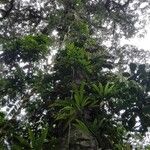A large evergreen tree. It grows to 50 m high. The trunk is 1.5 m across. It has buttresses. The branches have a cottony covering. The leaves are alternate and simple. They are 5-10 cm long by 2.5-5 cm wide. The flowers are pink and white. They have a sweet smell. Fruit are oval and 6 cm long by 4 cm wide. They are red-brown and have a warty surface. This is hard and woody. There are 1-2 seeds per stone.
Leaf-lamina up to 10 x 3·5 cm., narrowly elliptic or lanceolate-elliptic, apex usually acuminate or subacuminate, very rarely acute, base usually acute, sometimes rounded, never subcordate, lateral nerves in 22–24 pairs; petiole 0·5–1 cm. long; stipules up to 2 x 0·2 cm., papery, caducous.
Inflorescence terminal and axillary, up to 12 x 9 cm., lax or congested; inflorescence-axes and outside of flowers fulvous-or grey-tomentose.
Stamens 8; filaments 0·2 cm. long; staminodes 7–8, 0·02–0·1 cm. long.
Bark fairly smooth or with deep longitudinal fissures.
Pale tomentose branchlets and inflorescence
Large evergreen tree up to 35 m. tall.
Fruit rough-skinned, sometimes eaten.
Crown rounded, dense, dark green.
Receptacle-tube 0·2–0·3 cm. long.
Sepals and petals 0·25 cm. long.
Drupe ellipsoid c. 4 x 2·5 cm.
A large evergreen forest tree
Style 0·25–0·35 cm. long.


